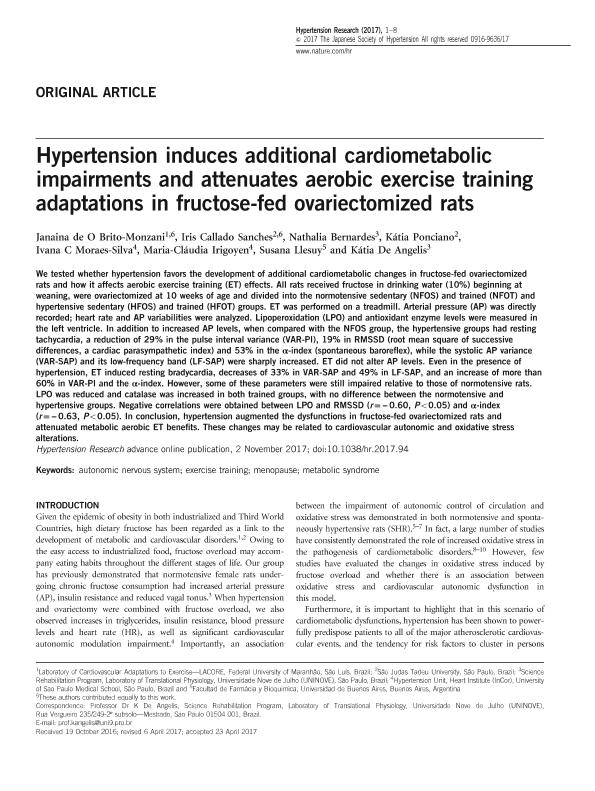Artículo
Hypertension induces additional cardiometabolic impairments and attenuates aerobic exercise training adaptations in fructose-fed ovariectomized rats
De Brito Monzani, Janaina O.; Sanches, Iris Callado; Bernardes, Nathalia; Ponciano, Kátia; Moraes Silva, Ivana C.; Irigoyen, Maria Cláudia; Llesuy, Susana Francisca ; De Angelis, Kátia
; De Angelis, Kátia
 ; De Angelis, Kátia
; De Angelis, Kátia
Fecha de publicación:
02/11/2017
Editorial:
Nature Publishing Group
Revista:
Hypertension Research
ISSN:
0916-9636
Idioma:
Inglés
Tipo de recurso:
Artículo publicado
Clasificación temática:
Resumen
We tested whether hypertension favors the development of additional cardiometabolic changes in fructose-fed ovariectomized rats and how it affects aerobic exercise training (ET) effects. All rats received fructose in drinking water (10%) beginning at weaning, were ovariectomized at 10 weeks of age and divided into the normotensive sedentary (NFOS) and trained (NFOT) and hypertensive sedentary (HFOS) and trained (HFOT) groups. ET was performed on a treadmill. Arterial pressure (AP) was directly recorded; heart rate and AP variabilities were analyzed. Lipoperoxidation (LPO) and antioxidant enzyme levels were measured in the left ventricle. In addition to increased AP levels, when compared with the NFOS group, the hypertensive groups had resting tachycardia, a reduction of 29% in the pulse interval variance (VAR-PI), 19% in RMSSD (root mean square of successive differences, a cardiac parasympathetic index) and 53% in the α-index (spontaneous baroreflex), while the systolic AP variance (VAR-SAP) and its low-frequency band (LF-SAP) were sharply increased. ET did not alter AP levels. Even in the presence of hypertension, ET induced resting bradycardia, decreases of 33% in VAR-SAP and 49% in LF-SAP, and an increase of more than 60% in VAR-PI and the α-index. However, some of these parameters were still impaired relative to those of normotensive rats. LPO was reduced and catalase was increased in both trained groups, with no difference between the normotensive and hypertensive groups. Negative correlations were obtained between LPO and RMSSD (r=-0.60, P<0.05) and α-index (r=-0.63, P<0.05). In conclusion, hypertension augmented the dysfunctions in fructose-fed ovariectomized rats and attenuated metabolic aerobic ET benefits. These changes may be related to cardiovascular autonomic and oxidative stress alterations.
Palabras clave:
AUTONOMIC NERVOUS SYSTEM
,
EXERCISE TRAINING
,
MENOPAUSE
,
METABOLIC SYNDROME
Archivos asociados
Licencia
Identificadores
Colecciones
Articulos(IBIMOL)
Articulos de INSTITUTO DE BIOQUIMICA Y MEDICINA MOLECULAR
Articulos de INSTITUTO DE BIOQUIMICA Y MEDICINA MOLECULAR
Citación
De Brito Monzani, Janaina O.; Sanches, Iris Callado; Bernardes, Nathalia; Ponciano, Kátia; Moraes Silva, Ivana C.; et al.; Hypertension induces additional cardiometabolic impairments and attenuates aerobic exercise training adaptations in fructose-fed ovariectomized rats; Nature Publishing Group; Hypertension Research; 41; 2; 2-11-2017; 88-95
Compartir
Altmétricas



